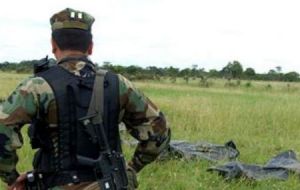MercoPress. South Atlantic News Agency
IISS: cross-border sanctuaries have been key for the survival of Colombia’s FARC
 A raid by Colombian forces into Ecuador in March 2008 not only killed a leader of FARC but captured a wealth of information
A raid by Colombian forces into Ecuador in March 2008 not only killed a leader of FARC but captured a wealth of information The ability of Colombia’s largest insurgent group, the Revolutionary Armed Forces of Colombia – People’s Army (FARC), to rely on cross-border sanctuaries has long been key to its survival, according to the International Institute for Strategic Studies.
Not only do these sanctuaries provide FARC with military and logistic advantages, they also constitute important bases from which FARC can promote its political agenda, aimed at achieving recognition as a belligerent and degrading the Colombian government’s international standing and relations with neighbouring states.
This IISS Strategic Dossier, The FARC Files: Venezuela, Ecuador and the Secret Archive of ‘Raúl Reyes’, is based on a two-year study of the e-mails and strategic documents recovered by the Colombian security forces during a raid on a FARC camp, located just inside Ecuador, occupied by Luis Edgar Devía Silva, aka Raúl Reyes, a member of FARC’s seven-man Secretariat and head of its International Committee (COMINTER).
The Reyes archive offers unprecedented, almost real-time insights into the strategic thinking, operational activities and behaviour of FARC and its relations with a wide range of actors from the Andean region and beyond. It fills a major gap in our understanding of the recent history of the Andean region.
The dossier illustrates how FARC, which in its early years had a limited tactical repertoire and a theatre of operations confined to the rural areas of central Colombia, developed an ambitious road map to power that would seek to spread guerrilla warfare across the countryside; manipulate social and political tensions in the cities; exploit the desire of other actors in the conflict to secure peace while itself remaining committed to a military victory; and obtain political and material support from beyond Colombia’s borders.
As FARC fortunes on the battlefield waned, the role of the COMINTER only increased in importance as FARC sought to: obtain weaponry, such as man-portable air-defence systems (MANPADs), to alter the military balance in Colombia; achieve political recognition and formal status as a belligerent; impose its own narrative internationally at the expense of the Colombian government; damage Colombia’s relations with neighbouring states and use its border enclaves to deal with a range of actors out of reach of Colombian security forces.
The dossier illuminates in detail FARC efforts to develop relationships with the governments and other strategic actors in the neighbouring states of Venezuela and Ecuador. These followed different trajectories and achieved different degrees of success.
The relationship with Venezuela ultimately acquired a strategic dimension characterised by various forms of state support, whereas that with Ecuador did not. FARC has suffered many setbacks following the loss of the Reyes archive, and the archive itself has put FARC relations with neighbouring states under the spotlight in ways that have significantly constrained the group’s development.
But FARC has lived to fight another day, at least in part due to its continued access to cross-border sanctuaries. It continues to pose a threat to the stability of Colombia and the Andean regimes.




Top Comments
Disclaimer & comment rules-

Read all commentsI imagine the Presidenta of Unasur will soon put a stop to FARC sanctuaries and their attempts to destabilise the andean nations.
May 11th, 2011 - 06:18 pm 0Commenting for this story is now closed.
If you have a Facebook account, become a fan and comment on our Facebook Page!